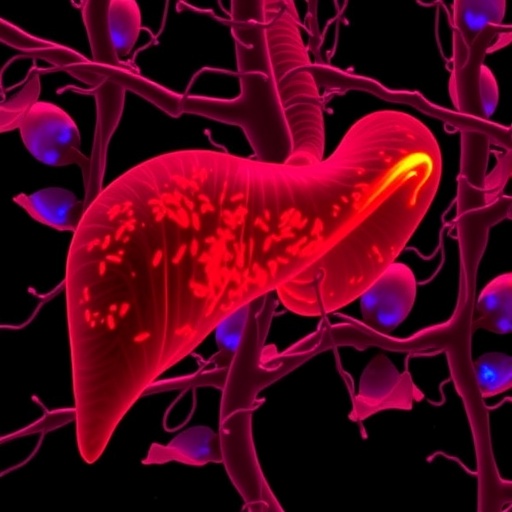In the realm of cancer research, the understanding of tumor microenvironments continues to evolve, offering deeper insights into how various cellular components interact and influence cancer progression. One of the most intriguing areas of investigation is the role of tertiary lymphoid structures (TLS) and cancer-associated fibroblasts (CAFs) in hepatocellular carcinoma (HCC), particularly in cases complicated by portal vein tumor thrombus (PVTT). Recent studies, including those conducted by Hu, Chen, Xiao, and their team, have highlighted the prognostic significance of these components, shedding light on their potential as therapeutic targets and biomarkers in HCC.
Hepatocellular carcinoma is notoriously aggressive, and the presence of portal vein thrombus indicates a particularly advanced stage of the disease. In these cases, the interaction between tumor cells and the surrounding microenvironment can dictate patient outcomes. The study emphasizes that TLS, which are ectopic lymphoid structures that resemble secondary lymphoid organs, can emerge in solid tumors and may play a critical role in orchestrating immune responses against cancer. The presence of TLS in HCC has been associated with improved patient prognosis, suggesting a possible protective mechanism mediated by local immune activation.
The article elaborates on how cancer-associated fibroblasts, the primary components of the stroma in tumors, affect the progression of HCC. These fibroblasts are not mere structural elements; instead, they actively participate in the tumorigenic processes by secreting a variety of cytokines and growth factors. Their interaction with immune cells and tumor cells can either promote or hinder tumor growth, depending on the context. The enigmatic nature of CAFs complicates our understanding, as they can exhibit diverse phenotypes that lead to contrasting effects on tumor progression.
Studies have shown that the spatial organization of TLS and the density of CAFs within the tumor microenvironment can provide valuable prognostic information. Increased TLS density often correlates with a favorable immune response, which can lead to reduced tumor burden. Conversely, high levels of CAFs may indicate a more aggressive tumor phenotype, contributing to fibrosis and overall tumor progression. This duality underlines the complexity of the tumor microenvironment, where immune and stromal components continuously interact and evolve.
Importantly, Hu and colleagues have dissected the interplay between TLS and CAFs, revealing that their relationship is not merely antagonistic or cooperative. Rather, they influence each other in multifaceted ways, which complicates our attempts to predict clinical outcomes. By analyzing tissue samples from HCC patients, the researchers found distinct patterns of TLS and CAF distribution that corresponded with various clinical parameters, including tumor stage and patient survival times. These findings underscore the necessity for a nuanced interpretation of tumor microenvironments when devising treatment strategies.
Furthermore, the work of Hu et al. contributes to the growing body of evidence that points toward the potential of harnessing TLS and CAFs for therapeutic purposes. The possibility of stimulating TLS formation in HCC, or targeting specific CAF subtypes to alter their pro-tumorigenic effects, represents an exciting frontier in cancer treatment. Future therapies could be designed to modulate these microenvironment components, leading to improved outcomes for patients suffering from advanced HCC.
The incorporation of advanced imaging techniques and single-cell genomics may provide further insights into the dynamic interactions between TLS, CAFs, and tumor cells. By employing these techniques, researchers can unveil the cellular heterogeneity within HCC and better understand the mechanisms underlying tolerance and immune evasion by tumors. This knowledge is critical for the development of more effective therapeutic strategies that leverage the immune system to combat cancer.
In light of the complexity of HCC and its clinical management, the implications of Hu and colleagues’ findings are profound. As clinicians and researchers work to unravel the complexities of tumor biology, the study emphasizes that understanding the microenvironment is as crucial as investigating the tumor cells themselves. Personalized medicine approaches that consider TLS and CAF profiles may offer a pathway toward more targeted and effective interventions.
Notably, the research raises significant questions regarding the optimal patient selection criteria for novel immunotherapies and anti-fibrotic treatments. Closer examination of TLS and CAF characteristics could enhance our ability to stratify patients based on their likelihood of response to specific therapies, ultimately aiming to tailor treatments that maximize efficacy while minimizing adverse effects.
The contributions of Hu et al. exemplify the importance of collaborative research efforts in advancing our understanding of cancer. By integrating knowledge from immunology, oncology, and molecular biology, the study sets the stage for a cross-disciplinary approach that could inspire future discoveries in the field. As researchers continue to explore the interactions within the tumor microenvironment, the hope is to unlock new dimensions of cancer therapy that not only combat tumor growth but also restore and enhance the body’s natural immune defenses.
In summary, the prognostic impact of tertiary lymphoid structures and cancer-associated fibroblasts in hepatocellular carcinoma with portal vein tumor thrombus presents a compelling narrative that emphasizes their dual roles in cancer progression and immune response. The work of Hu, Chen, Xiao, and their collaborators underscores the intricate balance of these elements within the tumor microenvironment and highlights their potential as biomarkers and therapeutic targets. As the landscape of cancer research continues to evolve, future studies will undoubtedly build upon these foundational insights, propelling us closer to a comprehensive understanding of cancer biology and treatment.
Subject of Research: The prognostic impact of tertiary lymphoid structures and cancer-associated fibroblasts in hepatocellular carcinoma with portal vein tumor thrombus.
Article Title: Prognostic impact of tertiary lymphoid structures and cancer-associated fibroblasts in hepatocellular carcinoma with portal vein tumor thrombus.
Article References:
Hu, L., Chen, C., Xiao, Y. et al. Prognostic impact of tertiary lymphoid structures and cancer-associated fibroblasts in hepatocellular carcinoma with portal vein tumor thrombus. Sci Rep (2025). https://doi.org/10.1038/s41598-025-28296-9
Image Credits: AI Generated
DOI: 10.1038/s41598-025-28296-9
Keywords: Hepatocellular carcinoma, portal vein tumor thrombus, tertiary lymphoid structures, cancer-associated fibroblasts, tumor microenvironment, prognostic biomarkers, immunology, cancer therapy.




